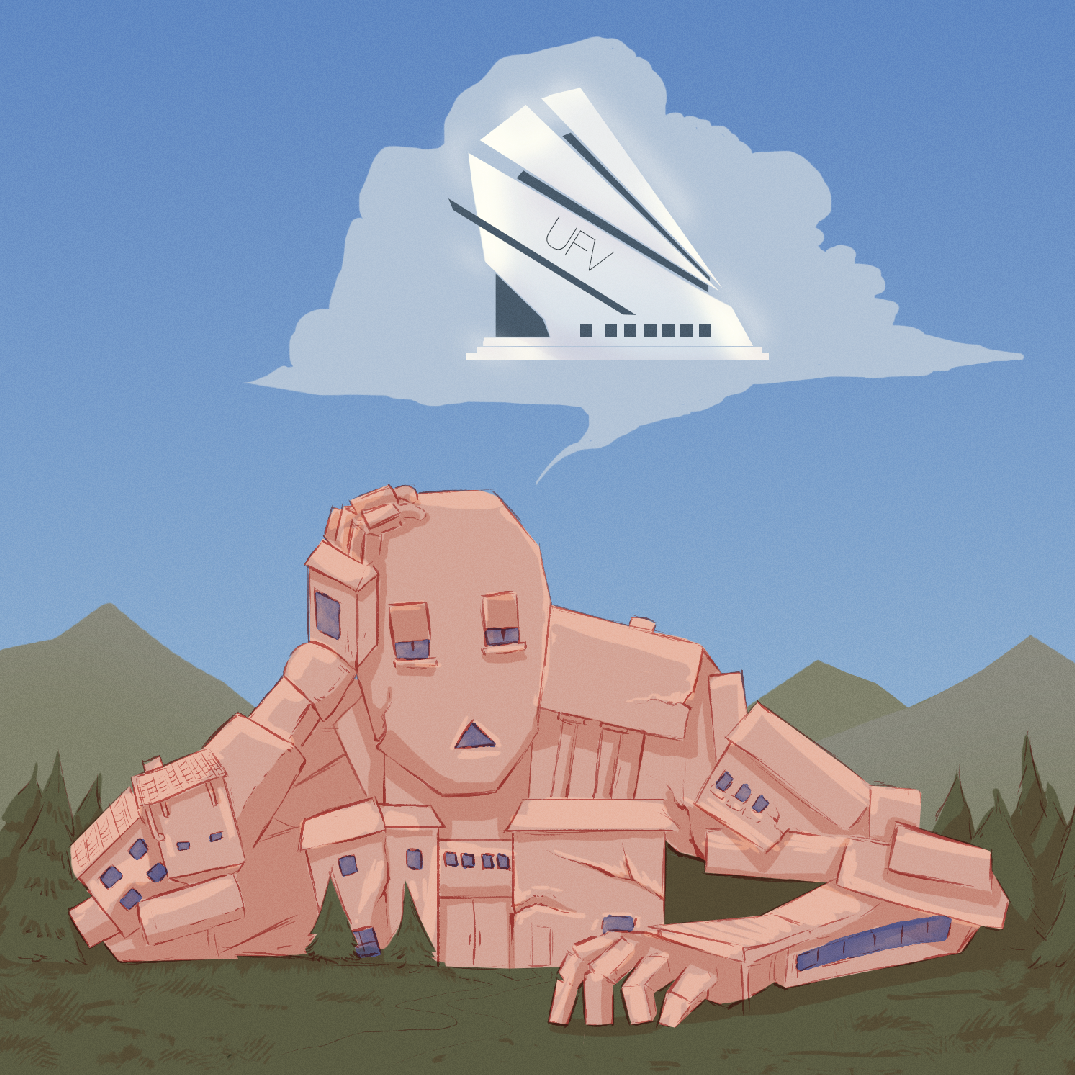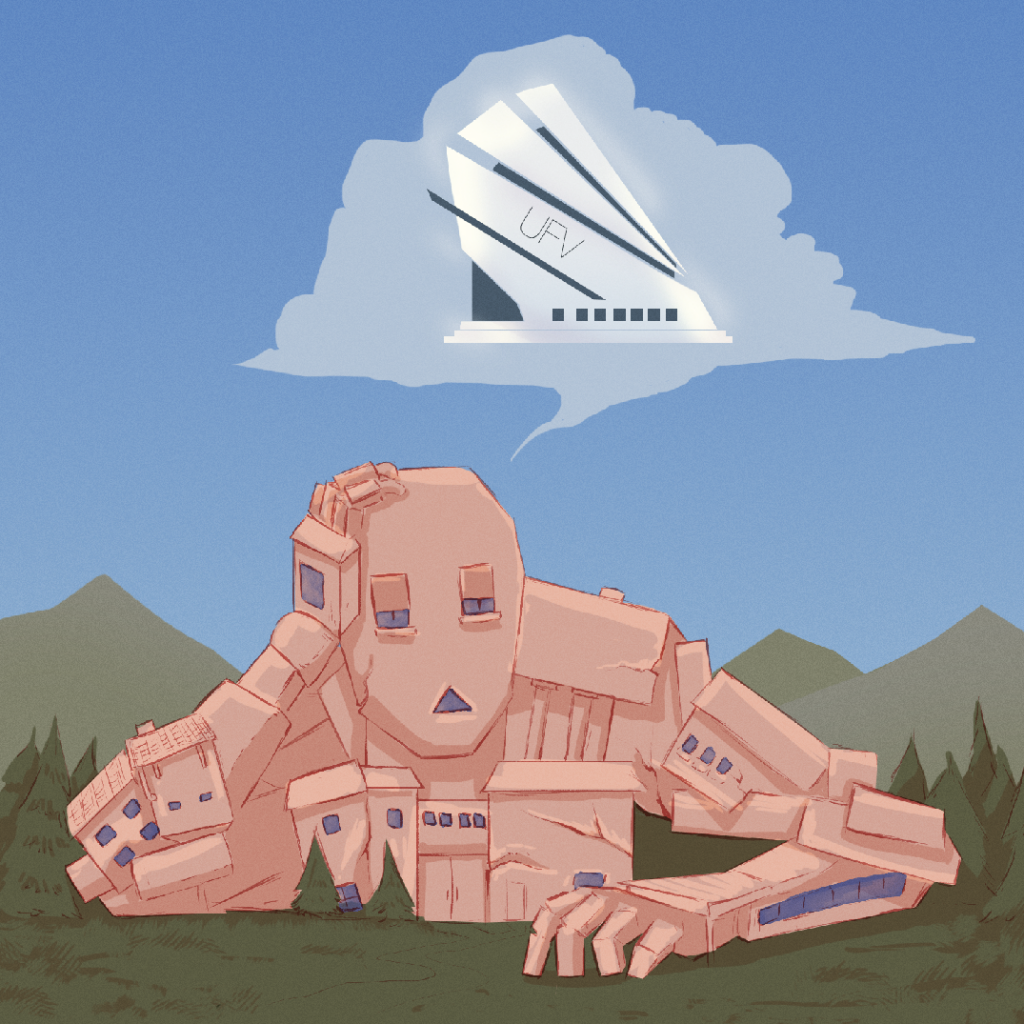By Michael Scoular (The Cascade) – Email
What does a university’s dreams look like? There are, perhaps, too many people working at too many different levels to say, in a simple, resolution-statement kind of way, that there is one dream, and this is where it is, and this is how close it is to reality. But if you pull out a single book, or a single document, sometimes you can find a very clear distillation of what is going on, or dreamt to be possible, in the hallways and offices of an institution.
Campus planning is one department at UFV where it could be said that the people who work there get to dream for a living — it’s not always that simple, of course, but every year they produce a Capital Plan — building projects, renovations, sales, purchases, all figuring in the millions, all dependent on a majority investment from the provincial government. If UFV had its greatest wishes fulfilled, the decision-makers from Victoria gazing down and deciding, yes, UFV deserves to have its requests granted, the contents of the Capital Plan would be the most noticeable changes to the university — buildings that would make its surfaces unrecognizable to alumni, and alterations that would disrupt the background operations of nearly every department at the institution.
Of course, there’s still reality to contend with.
“We haven’t received any indication from government that they’re going to fund any of these projects,” says Craig Toews, the director of campus planning. “It’s really a wish list, to the extent that these are what our priorities are, and these are the needs they would fill.”
Still, the university, not desiring to stand still, will naturally be looking ahead to another project: are any of these close to becoming reality, and what do these priorities say about UFV?
The most direct connection to the individual student’s life is the space all these buildings and construction timelines would take up: currently, UFV is over-capacity in Abbotsford, and in the Chilliwack transition from the Yale Road campus to the CEP building, some departments are now even more split between commuter campuses. The Capital Plan calls CEP a “destination campus,” and mentions that the Student Union Society’s shuttle connector is instrumental in many students actually getting to access the place. Where Abbotsford is aging, filling every available space, as it did this summer following the SUB move-out, with more offices and classrooms, Chilliwack is utilized at under 70 per cent of its capacity.
What, then, are the priorities of the Capital Plan? These fall into two main categories: new buildings and renovations. On the one side, a $40 million idea for a modern, technology-enhanced classroom building in Abbotsford, an additional floor to C building in Abbotsford, the purchase of a military building in Chilliwack for the heavy mechanics program. On the other, repairs to D building (those exterior cracks do mean something, and it does have something to do with why the building feels less insulated in some classrooms than elsewhere on campus), and maintenance renovations for A and B buildings in Abbotsford.
As Toews says, none of this is funded. And the calendar keeps turning, and student calendars remain bound to what space their classes are in, and, as it currently stands, nowhere in the Capital Plan does it suggest UFV is thinking about updating already-existing classrooms — it needs to fix what is looking like it will be broken within five years first.
Yet talk to professors, or students, and they’ll bring up inconveniences that pile up: classrooms that might trigger flashbacks to high school, complete with overhead projectors (the choice: use, or awkwardly transition between rooms); unreliable technology that would make a tech-heavy building a strange beast if UFV were still running on Blackboard by that date; and the strange experience of walking through a supposedly fully-utilized building, only to find, without difficulty, a empty class to rehearse a presentation in.
These are the minutiae of space planning, and not all of them would ever fall within the pages of a large-overview Capital Plan. Toews points out that there is currently a “course-scheduling taskforce” looking into ways that every interaction with the Office of the Registrar is pain-free and more efficient in the future.
But if a recent discussion at Senate is any indication, while the exploratory work done there may be valuable, it won’t revolutionize the student experience: de-registering students more stringently who don’t attend on the first day, reducing waitlist uncertainty, may make a lot of sense on the back-end of operations, but for students, it would be just another extra step, like the $200 pre-registration fee.
These are all plans, administrators will remind anyone who asks. Plans change, are never meant to be set in stone when they are this broad. Wait around, and plans and taskforces may become solutions. But the student life is always impatient. It can’t afford to wait five years. The reality is what it is, and who can say where it will go, and so on, but right now, the situation is as simple as this: UFV is a commuter campus. Which means a student, on any given day, will walk or drive from a sleek modern structure to an aging classroom that covers the necessities, but does not inspire them. They will be expected to do just as well in both settings; and many will welcome the challenge. But through it all, they will encounter a UFV with a splintered identity — that’s the reality of a place in transition, and no one department is necessarily the cause of this, but it’s still a thing students dream about: a university that looks better than the one they’re learning in.
With files from Sonja Klotz





